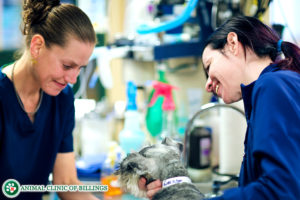Angular Limb Deformities (ALD)
What is an angular limb deformity (ALD)?
An angular limb deformity is an abnormal bend or twist in a limb resulting in a loss of normal bone and joint alignment. The three most common types of angular limb deformities in dogs are:
- Premature closure of the distal (lower) physis (growth plate) of the ulna (one of the paired bones of the forearm). This causes bowing of the radius as it continues to grow at its normal rate, resulting in lateral (outward) and caudal (backward) angulation and external rotation of the limb at the level of the forearm.
- Premature closure of the medial (inner) or lateral (outer) portion of the distal (lower) physis (growth plate) of the tibia (shin bone). Premature closure of the inner (medial) side of the growth plate, called pes varus, causes the lower portion of the limb to angle medially (inward) as the other side continues to grow. Conversely, premature closure of the outer (lateral) side of the growth plate, called pes valgus, causes the lower portion of the limb to angle laterally (outward).
- Malunion of a fracture. This occurs when a broken bone heals in improper alignment, leaving the limb with an abnormal bend and/or twist.
Depending on the severity of the deformity, it may exert excessive strain on the adjacent joints, causing arthritis, pain, and impaired limb use.
What causes angular limb deformities?
Angular limb deformities may result from a genetic predisposition to premature growth plate closure, trauma to an active growth plate (resulting in premature closure), or a malunion fracture. Chondrodystrophic (disproportionately short-legged) breeds such as the Dachshund, Basset Hound, Pekingese, Shih Tzu, and Lhasa Apso, are all affected by some degree of angular limb deformity. This is a consequence of the genetic abnormalities that give these breeds their distinctive appearance. Premature closure of the distal ulnar physis and premature closure of the medial aspect of the distal tibial physis are the most commonly observed angular limb deformities seen in these breeds. Premature closure of the lateral aspect of the distal tibial physis is most frequently encountered in Collies, Shetland Sheepdogs, Newfoundlands, Rottweilers, and other large and giant breeds. Trauma-induced premature growth plate closure can occur in any animal that is not yet fully grown, while malunion fractures can occur in animals of any age.
What are the signs of an angular limb deformity?
The presence of an angular limb deformity becomes increasingly evident as a young animal grows. Lameness ranges from absent to severe, depending on the degree of abnormal strain being exerted on the associated joints.
How are angular limb deformities diagnosed?
Angular limb deformities are diagnosed with a physical exam and x-rays. On physical exam, the patient’s gait is observed and the joints adjacent to the deformity are palpated. Pain, swelling, and reduced range of motion may be identified. Precisely positioned x-rays are used to assess the exact location, type, and severity of the malformation, and to evaluate its impact on the associated joints.
How are angular limb deformities treated?
Surgical correction is indicated to treat an angular limb deformity that is causing impaired limb use and discomfort. The surgery typically performed to address premature closure of the distal ulnar physis is called a dynamic proximal ulnar osteotomy (DPUO). In this surgery, a cut is made all the way through the ulna just below the elbow. The two cut ends separate to release tension on the wrist and elbow joints and allow ongoing growth of the radius to occur without further distortion. Other types of angular limb deformities are addressed with corrective osteotomies, in which a wedge of bone of a precise size and orientation is removed from the shaft of the bone at the level of the bend or twist, resulting in straightening of the bone as the cut edges are plated together.
The question of the optimal timing of surgical correction lacks a simple answer. If the surgery is not performed until an animal is fully grown, significant damage may have already been sustained by the adjacent joints, and in the case of premature closure of the distal ulnar physis, the longer growth continues without intervention, the more severe the bowing of the radius. On the other hand, if a corrective osteotomy is performed early in the growth process, there is a risk that with further growth, additional bending or rotation will occur that necessitate another surgery. When a DPUO is performed in a relatively young puppy, there is a risk that the cut ends of the ulna will heal before the radius finishes growing, resulting in the need to repeat the procedure. The decision of when (and if) a young animal should have surgery for their angular limb deformity should be made based on repeated physical exams to closely evaluate the progression of the abnormality and monitor for the development of pain or lameness over time.
What is the prognosis for an angular limb deformity?
The prognosis for an angular limb deformity depends on how much damage has already been sustained by the affected joints, but is generally good to very good. Any degenerative changes that are already present in the joint at the time of surgery cannot be reversed, but further progression can be slowed, and ongoing discomfort and inflammation can be alleviated with the use of medications, nutraceuticals, weight management, and physical rehabilitation therapy.

Let our highly trained and experienced team of veterinarians and veterinary technicians help you keep your cat as happy and healthy as they can be.
Call the Animal Clinic of Billings and Animal Surgery Clinic to schedule your pet cat’s next wellness examination with one of our veterinarians today!
406-252-9499 REQUEST AN APPOINTMENT
ANIMAL CLINIC OF BILLINGS AND ANIMAL SURGERY CLINIC
providing our region’s companion animals and their families what they need and deserve since 1981
1414 10th St. West, Billings MT 59102
406-252-9499



